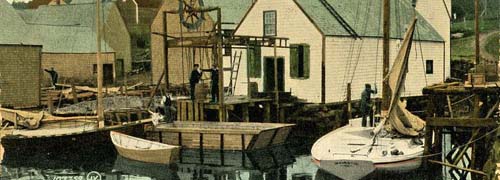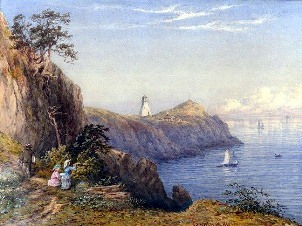 |
|
MUSEUM
MANDATE & HISTORY
|
Statement
of Purpose: The
Grand Manan Museum
collects, preserves, and
displays items that
represent the human and
natural history of the
Village of Grand Manan,
and the Islands of the
Grand Manan Archipelago.
It promotes education
and appreciation of the
community heritage,
culture, and physical
environment through
public programs and
exhibits. Your can read
our full Statement of
Purpose & Mission
(revised June 2014)
here.
|
|

Fish Warehouses and Wharves,
Seal Cove, Grand Manan. |
|
|
MUSEUM HISTORY
|
|
|
L. Keith
Ingersoll along with other
interested residents of Grand
Manan formed the Gerrish House
Society in 1961. On the 18th of
June, 1974, the name was changed
to the Grand Manan Museum. The
Museum preserves local Island
history and is permanent home to
the three hundred birds in the
Allan Moses Bird Collection.
This Collection was given to the
children of Grand Manan in 1951.
A 1967 centennial
project, the original museum
building was constructed through
donations and with funds from
the provincial and federal
government. In 1967, the Gannet
Light house Fresnell lens was
moved beside the Museum and in
1997 the new Gallery was built
around it.In 2013 the Museum
became a Member of the United
|
States
Lighthouse Society, and visitors
can now purchase a Lighthouse
Passport in our gift shop and
have their passport stamped for
visiting the Gannet Rock Light,
one of over 400 member
lighthouses in North America,
only a handful of which are in
Canada, In 1979, the historic
Deep Cove One-Room School House
was also moved to the grounds
behind the museum.
In 1997, the Museum was doubled
in size in order to store the
many artifacts and the Archives.
Islanders and island industries
of Grand Manan have always been
generous in keeping the Museum
alive and vibrant, and its
operation depends on volunteers,
gifts, and donations.
|
| |
|
MUSEUM
HISTORY IS GRAND MANAN
HISTORY:
Grand
Manan people live by
the sea, from the sea
and for the sea. |
|
|
|
|
Grand
Manan's first recorded
visitor was Diego Homen,
a Portuguese Captain who
described a cape of
Islands at the mouth of
the Bay of Fundy.
Captain
William Owen, a British
naval Captain visited in
1770 and may have caused
the Island to be
surveyed ten years
later. He recognizing it
as a potential area for
settlement.
|
|
In
the early nineteenth
century, Grand Manan
attracted small groups
of fishermen from the
United States and Nova
Scotia. Farming played a
key role in the
development of the early
settlement.
In
the years prior to 1820,
farming competed with
fishing as a way of
life. However, by 1850
torch fishing, weir
fishing and lobster
fishing became more
popular.
|
|
|
|
During
the last half of the
century Grand Manan
fishermen became masters
of their fishing grounds
by skill and
determination. As
fishing became a
commercial venture smoke
houses, ice and salt
houses, and sawdust
sheds sprang up along
the shoreline.
|
|
Tourism has played a
significant role in the
economy of the Island
since the late 19th
century. There are
several hotels and
cottages available for
the summer visitors.
Daily whale and bird
watching tours are also
a big draw to the
Island. Many trails of
various distances allow
the hiker to experience
the serenity of the out
doors and spectacular
views of the Island.
|
|
|
|
Lighthouses
With treacherous
ledges and tides of 29
feet, it was soon
realized that light and
fog stations were
essential to protect the
shipping route in and
out of the Bay of Fundy.
Before automation nine
manned lighthouses were
in operation around
Grand Manan. The first
of these was the
lighthouse built in
1831, on Gannet Rock.
|
|
Our
iconic lighthouse at
Swallowtail Head was
first lit in 1860, and
today it is one of the
most photographed lights
in Canada. The light
keeper's house, the
grounds and the light
tower are now the
property of a local
preservation
group.
|

|
|
| |
|
|
|